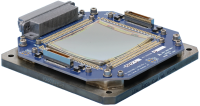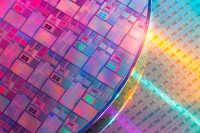Displaying news tagged: DARPA
HRL Project Will Develop Embedded Sensors for Wireless Structural Health Monitoring

HRL will develop embedded sensors for wireless structural health monitoring of load-bearing components in a new DARPA project. By embedding sensors during additive manufacturing processing, HRL aims to monitor stress and temperature of critical components to monitor loading and detect damage while also protecting the sensor from a harsh operating environment.
HRL Advances to Camera-Build Phase of Curved Sensor Technology

HRL Laboratories continues to advance curved sensor technology with new funding from DARPA to build an ambitious, first-of-its-kind test camera featuring curved infrared imaging sensors that make wide field-of-view imaging a reality.
HRL Laboratories Aims at Unprecedented High-Frequency Performance in Gallium Nitride MMICs Based on Traditional Silicon Semiconductor Fabrication Techniques

HRL Laboratories, LLC, is developing Efficient GaN Integrated G-band Monolithic Arrays (ENIGMA), a project funded by DARPA. ENIGMA will address a gap in technology between the compound semiconductor monolithic microwave integrated circuit industry and the silicon radio-frequency integrated circuit industry.
HRL Laboratories Selected for NOM4D Project to Develop Space-Based Construction Technologies

DARPA Program Aims to Revolutionize Large Space Structures by Developing New Techniques for on Orbit Manufacturing
Complex Analytics of Network of Networks – CANON

A new software system developed by HRL Laboratories will enable open-source intelligence analysts to track down adversarial activity through complex networks of networks worldwide.
STELLAR Program Aims for Autonomous Vehicles With Permanent Memories

HRL Laboratories has reached the second phase of its novel system aimed to give autonomous systems such as self-driving cars artificial intelligence the ability to learn new tasks and preserve experience without losing or displacing previous learning—features not possible with current AI systems.
Aiming to Improve Infrared Cameras by Curving Focal Plane Arrays

HRL Laboratories, LLC, scientists and engineers are taking on the challenge of developing sensors that are doubly-curved, like a bowl, under a new program from the Defense Advanced Research Project Agency (DARPA) sighted on the advancement of infrared (IR) vision. Such curved photographic sensors can enhance clarity throughout an image by bringing its corners into equal focus and brightness as the center.
MACH: Much Faster Than a Speeding Bullet

HRL Laboratories will design architected materials to be used on the leading edges of hypersonic aircraft as part of the Materials Architectures and Characterization for Hypersonics or MACH program from DARPA. Hypersonic vehicles fly at least five times the speed of sound. Leading edges are essential design features because they enable long-range travel at extremely high velocities while maintaining vehicle maneuverability.
CANON Enters New Phase to Increase Focus on Adversarial Activity

HRL Laboratories Complex Analytics of Network of Networks (CANON) system has achieved its second phase in the Modeling Adversarial Activity program, funded by the Defense Advanced Research Project Agency. CANON is a set of software tools that can “do the math” for intelligence analysts looking for activity directed by adversaries. Using integrated information from networks of networks, CANON analyzes and flags questionable adversarial activity.
Memory Boost With Just One Look

HRL Laboratories, LLC, researchers have published results showing that targeted transcranial electrical stimulation during slow-wave sleep can improve metamemories of specific episodes by 20% after only one viewing of the episode, compared to controls. The same technology may offer a non-invasive treatment to mitigate bad memories that might cause post-traumatic stress disorder (PTSD). Metamemory describes the sensitivity of whether memories are recalled accurately or not, such as during eyewitness testimony.